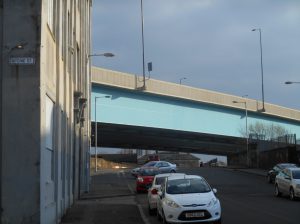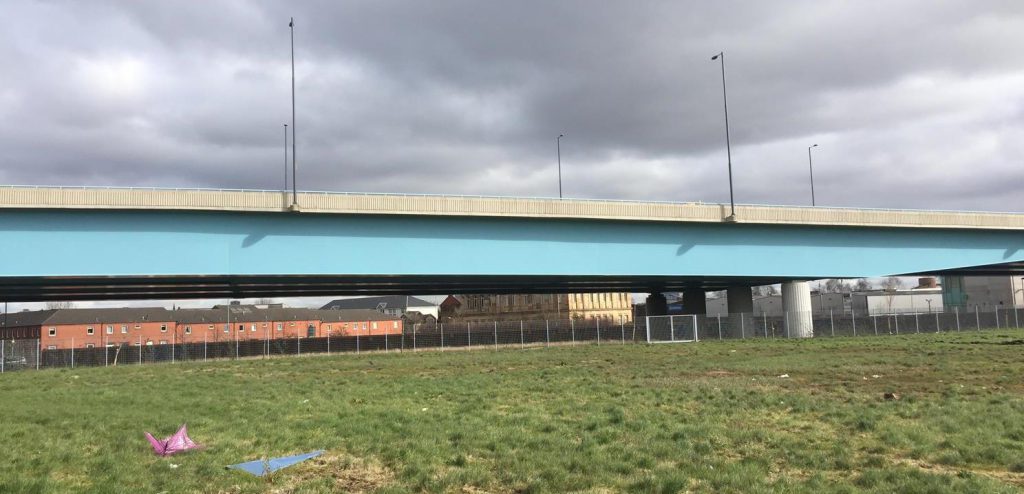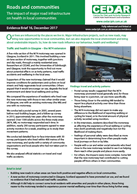The impact of major road infrastructure on health in local neighbourhoods – December 2017
Our lives are influenced by the places we live in. Major infrastructure projects, such as new roads, may bring new opportunities to local communities, but can also degrade the local environment and bring about undesirable impacts. So, how do new roads influence our behaviour, health and wellbeing?
Jump to:
Brief in brief
- Building new roads in urban areas can have both positive and negative effects on local communities.
- A new section of motorway constructed in Glasgow, Scotland appeared to have promoted car use, and we found no evidence that it had reduced road traffic casualties.
- Although it did help to connect some local residents with amenities and people in other places, those living nearer to the motorway tended to experience poorer mental wellbeing over time than those living further away.
Traffic and health in Glasgow – the M74 extension

A five-mile section of the M74 motorway was opened in Glasgow, Scotland in 2011. This involved building a new six-lane section of motorway, together with junctions and slip roads, through a mainly residential area.
Researchers at CEDAR, and the Universities of Edinburgh and Glasgow, took the opportunity to find out more about potential effects on activity patterns, road traffic accidents and wellbeing in the local area. Supporters of the new motorway claimed that it would improve conditions for pedestrians and cyclists on local streets and help regenerate local communities. Others argued that it would encourage car use, degrade the local environment and deter local walking and cycling.
We compared the experience of residents who lived near the new motorway with those in two other similar areas of Glasgow, one with an existing motorway (the M8) and one with no motorway.
We conducted a postal survey in 2005, several years before road-building began, and a follow-up survey in 2013, approximately two years after the motorway opened. Over 1300 adults across the three study areas (M74, M8, no motorway) responded each time. In addition, nearly 200 survey participants agreed to wear
activity monitors for a week, enabling us to study their movement patterns.
We conducted detailed face-to-face interviews with 30 survey participants who lived within 400 metres of the new motorway, and spoke with a variety of community organisations and local people who had not taken part in the survey.
We also analysed official statistics on travel and road traffic accidents.
Findings
Travel and activity patterns
- Postal survey results suggested that the M74 motorway promoted travel generally and, for those living near to a junction, car use more specifically.
- Those living closer to the existing M8 tended to report less physical activity over time than those living elsewhere.
- The M74 motorway did not seem to make any difference to the likelihood of reporting walking or cycling for travel, or to the total amount of physical activity recorded using monitors.
- In the interviews, residents described the motorway as affecting the experience of local walking or cycling trips (both positively and negatively) but not the
likelihood of making them. - Feelings of personal safety were described as more important in determining how often people made local journeys on foot or by bike.
- People with a car and wider social networks who lived close to the new motorway tended to see it as helping them reach other people and places more easily.
- For others, the impacts were more complex. Some felt that the new motorway had contributed to cutting people off from others in their communities.
Road traffic accidents
- Road traffic accidents were already declining sharply across the city before the new motorway was built, and we found no evidence that the opening of the M74 extension had any impact on this trend.
- In the interviews, some people described concerns about the speed of traffic on slip roads, altered street layouts and merging lanes of traffic, which may have contributed to the risk of accidents.
Wellbeing
- People living nearer to the new M74 motorway tended to experience poorer mental wellbeing over time than those living further away. We saw a similar pattern in the M8 area, but here it was concentrated among people living with a chronic illness or disability.
- Conversations with people living very close to the new road produced striking accounts of stark visual, noise, dust and other forms of disturbance.
- More time may be required for some benefits such as economic regeneration (which we did not assess directly) to become fully apparent and to impact on wellbeing in local communities.
Implications for policy
- Although the effects of a new motorway might have been different if it had been built somewhere else, our findings indicated how some of the overall health and social gains claimed for this type of investment may either not be achieved, or be achieved for some at the expense of others.
- Infrastructure projects like this may add further stress to already disadvantaged communities, and prolong or worsen existing social inequalities in
health. - New transport infrastructure is more likely to benefit more people when it connects rather than separates people from their social and physical
surroundings. - New infrastructure is also more likely to bring benefits when people are protected from its harmful environmental impacts.
- Involving local communities more closely in planning decisions can help planners understand possible benefits and harms of these infrastructure projects.

Traffic and Health in Glasgow Study Team
The study was led by the MRC Epidemiology Unit under the auspices of CEDAR in collaboration with the MRC/CSO Social and Public Health Sciences Unit and the Public Health group at the University of Glasgow, the University of East Anglia, the University of Edinburgh, the Glasgow Centre for Population Health and the Scottish Community Development Centre. The study was funded by the National Institute for Health Research (NIHR) Public Health Research programme.
References and resources
Research
- Study webpage: www.cedar.iph.cam.ac.uk/research/directory/traffic-health-glasgow
- Health impacts of the M74 urban motorway extension: a mixed-method natural experimental study. Ogilvie D, Foley L, Nimegeer A, Olsen J, Mitchell R, Thomson H, Crawford F, Prins R, Hilton S, Jones A, Humphreys D, Sahlqvist S, Mutrie N. Public Health Res 2017; 5: 3.
- Evaluating health effects of transport interventions methodologic case study. Ogilvie D, Mitchell R, Mutrie N, Petticrew M, Platt S. Am J Prev Med. 2006 Aug;31(2):118-26.
- Personal and environmental correlates of active travel and physical activity in a deprived urban population. Ogilvie D, Mitchell R, Mutrie N, Petticrew M, Platt S. Int J Behav Nutr Phys Act. 2008 Aug 27;5:43. doi: 10.1186/1479-5868-5-43.
- Effects of living near a new urban motorway on the travel behaviour of local residents in deprived areas: Evidence from a natural experimental study. Foley L, Prins R, Crawford F, Sahlqvist S, Ogilvie D; M74 study team. Health Place. 2017 Jan;43:57-65. doi: 10.1016/j.healthplace.2016.11.008. Epub 2016 Nov 26.
- Effects of living near a new urban motorway on the travel behaviour of local residents in deprived areas: Evidence from a natural experimental study. Foley L, Prins R, Crawford F, Sahlqvist S, Ogilvie D; M74 study team. Health Place. 2017 Jan;43:57-65. doi: 10.1016/j.healthplace.2016.11.008. Epub 2016 Nov 26.
- Effects of new motorway infrastructure on active travel in the local population: a retrospective repeat cross-sectional study in Glasgow, Scotland. Olsen JR, Mitchell R, Ogilvie D, M74 study team; Int J Behav Nutr Phys Act. 2016 Jul 7;13:77. doi: 10.1186/s12966-016-0403-9.
- Effects of new urban motorway infrastructure on road traffic accidents in the local area: a retrospective longitudinal study in Scotland. Olsen JR, Mitchell R, Mackay DF, Humphreys DK, Ogilvie D; M74 study team. J Epidemiol Community Health. 2016 Nov;70(11):1088-1095. doi: 10.1136/jech-2016-207378. Epub 2016 Jun 8.
- Effects of living near an urban motorway on the wellbeing of local residents in deprived areas: Natural experimental study. Foley L1, Prins R1, Crawford F2, Humphreys D3, Mitchell R4, Sahlqvist S5, Thomson H6, Ogilvie D1; M74 study team. PLoS One. 2017 Apr 5;12(4):e0174882. doi: 10.1371/journal.pone.0174882. eCollection 2017.
Policy
- M74 Completion. Transport Scotland
- Scottish National Transport Strategy: January 2016 (pdf). Transport Scotland, Edinburgh (2016).
Please cite this Evidence Brief as: UKCRC Centre for Diet and Activity Research (CEDAR), Evidence Brief 16 – Roads and communities – The impact of major road infrastructure on health in local communities – December 2017. www.mrc-epid.cam.ac.uk/resources/policy-resources/evidence-briefs/eb-roads-and-communities

 MRC Epidemiology Unit
MRC Epidemiology Unit